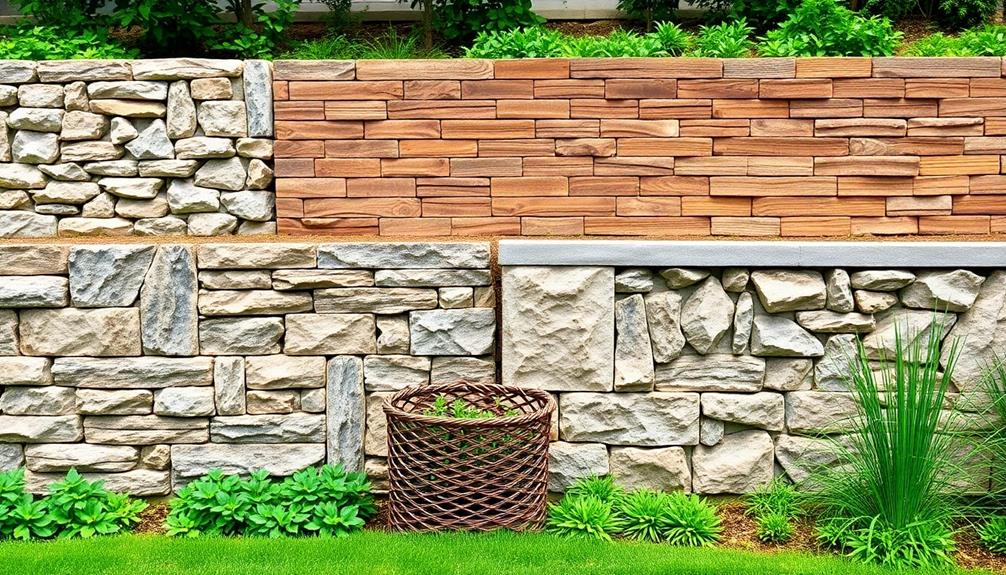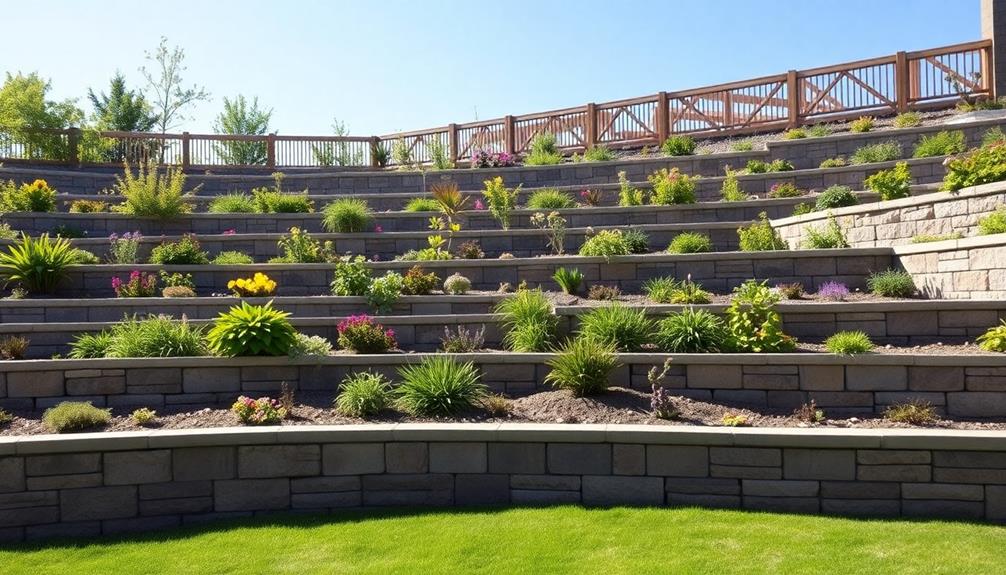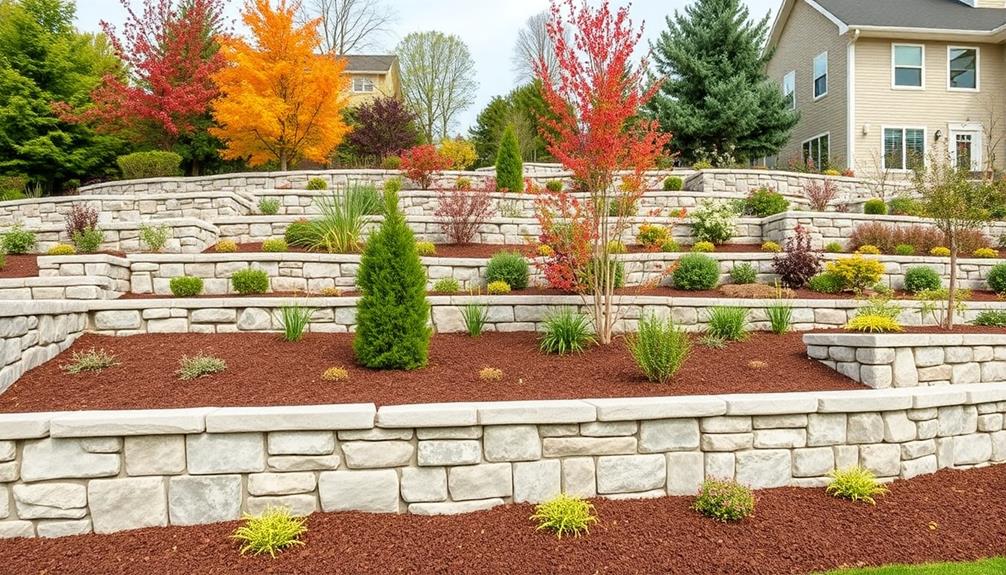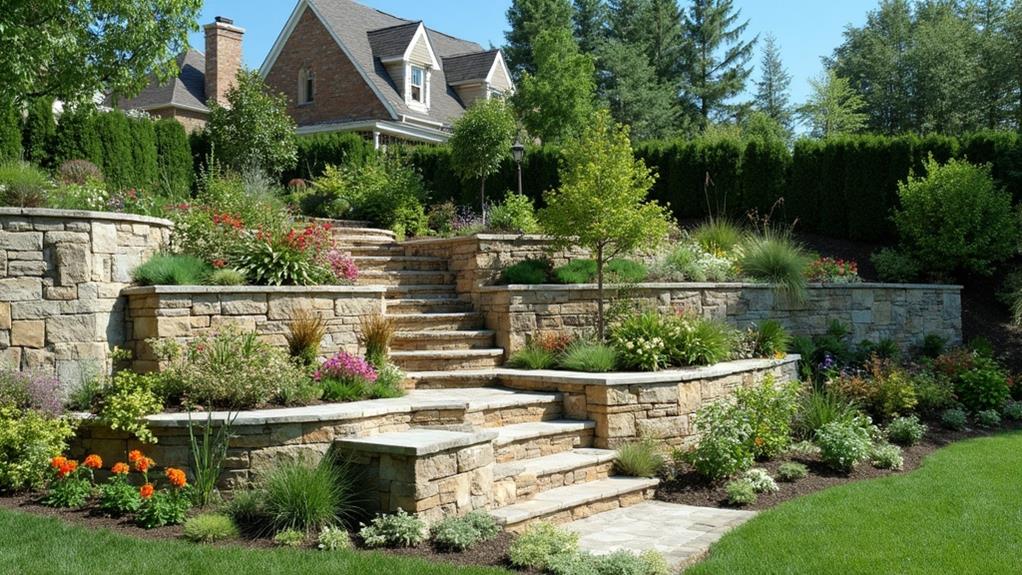Retaining walls can be constructed using various materials, each offering distinct benefits. Concrete blocks provide durability and structural integrity with diverse design options, ideal for contemporary or classic aesthetics. Natural stone offers timeless elegance and the ability to blend seamlessly with natural landscapes, featuring unique textures and colors. Timber and wood alternatives bring versatility and warmth, accommodating diverse landscape designs and offering sustainability options with higher durability. Each material choice affects durability and environmental impact, requiring careful consideration based on specific site conditions such as climate and moisture levels. Exploring these options can reveal ideal solutions for personal and environmental needs.
Table of Contents
ToggleWalls Contractor Highlights
- Concrete blocks offer strength, diverse designs, and straightforward assembly with interlocking systems.
- Natural stone provides timeless elegance and unique textures, harmonizing with landscapes.
- Timber and wood alternatives bring versatility, affordability, and natural warmth to retain structures.
- Geosynthetic materials offer lightweight, durable solutions for specific soil reinforcement applications.
- Poured concrete delivers exceptional structural integrity and lower lifetime costs for retaining walls.
Types of Retaining Wall Materials

In the domain of retaining wall construction, the choice of materials is a pivotal consideration, with options ranging from concrete blocks known for their strength and versatility, to the timeless appeal of natural stone, which offers a distinct aesthetic with its unique textures and colors.
Additionally, timber and wood alternatives present eco-friendly and cost-effective solutions, each bringing their particular advantages and challenges in the context of durability and environmental impact. Choosing the right material requires balancing these factors to meet both structural needs and design preferences, ensuring a functional and visually appealing result.
For instance, boulder retaining walls are celebrated for their long-term durability and can greatly enhance curbside appeal, while also serving both functional and decorative purposes.
Concrete Block Options
Concrete block options present several advantages and diverse design possibilities for constructing durable retaining walls. These blocks are known for their strength, long-lasting nature, and adaptability, positioning them as a preferred choice for many construction projects. Modern concrete blocks incorporate a range of design options, from sleek, contemporary finishes to those replicating classic stone aesthetics, enabling homeowners and developers to create visually appealing landscapes that foster a sense of belonging.
The structural integrity of concrete blocks secures they can withstand the pressures exerted by soil and water, making them an ideal choice for landscapes with demanding requirements. The interlocking nature of many concrete block systems facilitates straightforward assembly, enhancing efficiency and reducing construction timelines while still maintaining aesthetic continuity. This feature not only simplifies the installation process but also contributes to long-term stability.
Moreover, these blocks provide flexibility in regards to size and shape, allowing for tailored solutions that meet specific design visions and spatial constraints. This adaptability underscores their utility across various environmental settings, from residential gardens to expansive commercial sites. By combining functionality with design versatility, concrete block options continue to be a reliable and innovative component in the construction of effective retaining walls.
Natural Stone Choices
While concrete blocks offer modern versatility, natural stone choices provide a timeless and elegant option for retaining wall materials. Natural stone's allure lies in its unique textures, colors, and organic appeal, which harmonize seamlessly with natural landscapes. This material imbues structures with an authentic aesthetic that resonates with those who value connection with the natural environment. Each stone, inherently distinct, adds personality and character to retaining walls, crafting an inviting visual narrative that enhances the surrounding area's natural beauty.
A myriad of natural stone options are available, each offering distinct properties and visual effects. Limestone, with its muted, creamy hues, works well in compositions seeking tranquility and subtlety. Granite, admired for its durability and range of speckled colors, lends robustness and understated elegance. Sandstone offers warmth through its red and tan tones, ideal for evoking earthiness, while fieldstone, with rugged, irregular shapes, can creatively accommodate rustic design. Slate, with its unique ability to split into thin, flat slabs, provides a modern approach with a natural twist.
These natural stone choices not only stand the test of time aesthetically but also demonstrate remarkable resilience, ensuring that retaining walls maintain functionality and grace for generations.
Timber and Wood Alternatives
Among the various types of retaining wall materials, timber and wood alternatives stand out for their versatility and affordability. Timber, with its natural warmth and aesthetic appeal, is a popular choice for creating cohesive outdoor spaces that seamlessly integrate with the surrounding environment. It offers a unique, inviting texture and can be easily manipulated to accommodate various landscape designs. However, natural timber may face durability challenges over time due to weathering and susceptibility to pests, highlighting the importance of choosing high-quality, treated wood or considering robust alternatives.
Wood alternatives, such as composite materials or recycled plastic wood, present a sustainable option that mimics the traditional look of timber while offering enhanced longevity. These materials maintain the charm of natural wood and often come with the added benefits of resistance to rot, insects, and decay. With a focus on sustainability, these alternatives can be produced using environmentally friendly techniques, appealing to those who value ecological considerations in their construction choices. Whether constructing a simple garden bed or a more elaborate landscape structure, selecting either timber or its alternatives can create a beautiful, long-lasting retaining wall, fostering a sense of belonging within the space.
Benefits

When selecting materials for retaining walls, an analysis of the benefits reveals that durability and longevity are paramount, ensuring structural integrity and reduced maintenance over time. Boulder walls, for instance, are durable and low-maintenance options that can withstand harsh weather conditions.
Aesthetic appeal is another essential factor, as various materials offer diverse options to complement landscape designs while enhancing visual aesthetics. Additionally, considerations of cost-effectiveness and environmental impact play significant roles in guiding material choice, balancing budgetary constraints with sustainable practices.
Durability and Longevity
Investing in the right retaining wall materials can greatly enhance both the durability and longevity of your structure, offering tangible benefits to property owners. Durable materials, such as concrete, stone, and certain metals, provide lasting resilience against natural elements, ensuring that structures withstand environmental pressures such as soil erosion, heavy rains, and seasonal changes. The choice of material can profoundly influence a wall's life span, with superior options offering a reduction in maintenance needs and repair frequency.
The longevity of a retaining wall has implications for both economic and environmental sustainability. A robust structure reduces the necessity for replacements, conserving resources and minimizing costs over time. Additionally, well-chosen materials resist degradation from extreme temperatures and moisture, preserving functionality and aesthetic value.
Property owners who prioritize durability are not only investing in structural integrity but are also fostering a lasting sense of security and stability within their environment. This communal commitment to quality and durability provides a shared reassurance that these essential structures will endure through generations, maintaining the beauty and functionality of shared spaces. A carefully selected material thus serves as a long-term asset in residential and commercial landscapes.
Aesthetic Appeal Options
The aesthetic appeal of retaining walls goes beyond mere functionality, allowing property owners to seamlessly blend these structures into the surrounding landscape while enhancing visual interest. Retaining walls serve as more than just structural necessities; they are opportunities for artful expression within an outdoor space. By carefully selecting materials, textures, and colors that complement existing elements, retaining walls can transform an otherwise mundane area into an engaging visual experience. Materials such as natural stone, timber, brick, and concrete offer a variety of aesthetic choices, each adding unique character to a property.
Natural stone exudes timeless elegance, harmonizing with the earth's surroundings and conveying a sense of permanence. Timber, with its organic warmth, creates a rustic charm that resonates deeply with those who prize natural beauty. Bricks, on the other hand, provide a traditional allure, lending a sense of nostalgia and uniformity that can unify disparate design elements. Concrete, renowned for its versatility, can be fashioned into intricate designs or seamless monolithic forms, offering a contemporary aesthetic that appeals to modern sensibilities.
Ultimately, these aesthetic options invite property owners to express personal taste and foster environments where community and nature coexist, cultivating a sense of place and belonging.
Cost-Effectiveness Analysis
Evaluating the cost-effectiveness of retaining wall materials is pivotal for ensuring both economic efficiency and long-term value. In the domain of construction, this analysis allows for a meticulous understanding of not just the initial expenditure, but also the ongoing maintenance and potential repair costs associated with each material choice.
Durability plays a significant role here; materials like poured concrete and stone, although more expensive initially, often offer lower lifetime costs due to their resilience and reduced maintenance needs.
Conversely, materials such as timber, while appealing for their affordability and ease of installation, may incur higher cumulative costs over time due to susceptibility to decay and damage, necessitating more frequent repairs or replacements. The longevity of geosynthetic options further complicates this financial balancing act, as these provide innovative solutions that require an understanding of their unique installation methods and potential longevity versus upfront costs.
For a community or individual, making informed decisions about material selection fosters a sense of inclusion in the sphere of sustainable practices. This shared commitment to choosing wisely translates to retaining walls that are not only physically robust but also symbols of collective foresight, harnessing the strength of informed, economically prudent choices that support broader societal goals.
Environmental Impact Considerations
One of the many advantages in selecting retaining wall materials is their potential to minimize environmental impact. As stewards of our environment, choosing materials that align with sustainable practices is a shared responsibility that fosters a sense of collective belonging and purpose.
Environmentally-friendly retaining wall options, such as recycled materials, confer a shared benefit by reducing the strain on natural resources. They are processed in a manner that minimizes waste and utilizes raw materials efficiently, fostering a cycle of sustainability.
Concrete, for instance, can be produced using fly ash, a byproduct of coal combustion, which reduces landfill waste while enhancing durability. Retaining walls made from timber harvested through certified sustainable forestry practices guarantee that forest ecosystems remain abundant and resilient for future generations.
Additionally, natural stone, when sourced locally, not only reduces transportation emissions but also preserves the aesthetic integrity of the landscape, nurturing a deep connection with the local environment.
Green walls, engineered with living plants, offer environmental benefits by improving air quality and increasing biodiversity. These living structures not only create inviting, communal spaces but also embody the essential principle of harmony between built and natural environments, aligning our endeavors with a universally positive impact.
Local Climate Impact Considerations

When considering retaining wall materials, attention must be paid to the local climate's influence, specifically with regards to selecting weather-resistant materials that can withstand environmental stresses, addressing thermal expansion challenges that may lead to structural instability, and evaluating the moisture's effect on the material's durability. Each of these factors demands careful consideration to guarantee the longevity and functionality of the retaining wall in diverse climates. The following table outlines key material considerations relative to different climate impacts:
| Climate Impact | Material Consideration | Potential Issue |
|---|---|---|
| Weather Resistance | Use of UV-resistant coatings | Fading and degradation |
| Thermal Expansion | Selection of flexible materials | Cracking and warping |
| Moisture Effect | Implementing drainage solutions | Erosion and rot |
Weather-Resistant Materials Selection
Selecting weather-resistant materials for retaining walls is pivotal in ensuring their longevity and performance, especially considering the local climate's unique challenges. Depending on regional weather conditions, such as heavy rainfall, extreme temperature fluctuations, or high winds, different materials may be more appropriate.
For instance, in areas with high precipitation, selecting materials like concrete, stone, or treated timber, which are impermeable and resistant to moisture infiltration, is essential to prevent erosion and structural failure.
Conversely, in regions frequently experiencing intense sunlight and heat, retaining wall materials must resist UV degradation and avoid becoming brittle. Brick and concrete blocks, especially those formulated with additives for enhanced UV resistance, can provide enduring sturdiness in such environments.
In frost-prone areas, materials need to withstand freeze-thaw cycles without cracking; hence, selecting natural stone or concrete with air-entrainment properties may be beneficial.
Landscaping experts and construction professionals often advise engaging with local suppliers who possess a profound understanding of the local climate nuances, ensuring that material choices enhance both functionality and aesthetic cohesion with the surrounding environment. Ultimately, successfully integrating weather-resistant materials requires a careful assessment of these climatological demands, striking a harmonious balance between form, function, and durability.
Thermal Expansion Challenges
In regions where temperature fluctuations are significant, thermal expansion presents a consequential challenge for retaining wall integrity. This dynamic process occurs when materials expand and contract due to temperature changes, potentially leading to structural stress and material fatigue over time. Retaining walls, designed to manage soil and prevent erosion, must cope with these variances to guarantee longevity and safety. Selecting materials that can accommodate these movements without compromising structural stability is indispensable in climate-sensitive locations.
Concrete, a popular choice for retaining walls, is particularly susceptible to thermal expansion, which can result in cracking if not properly managed. Incorporating expansion joints strategically along the wall's length can mitigate the stress caused by expansion and contraction cycles. Alternatively, the use of materials that inherently possess a higher thermal tolerance, such as certain types of stone or engineered wood, can also be considered.
Simultaneously, thermal expansion should be addressed during the design phase by incorporating thermal analysis into structural calculations, ensuring the materials and construction techniques selected are suited to the climate's demands. By acknowledging and planning for thermal challenges, communities can build retaining walls that stand the test of time, fostering a sense of safety and resilience amid climatic uncertainties.
Moisture Effect on Durability
Retaining walls are continually exposed to moisture, a critical factor affecting their durability, especially in climates with high rainfall or humidity levels. In such environments, water infiltration can compromise the structural integrity of retaining walls, leading to issues such as soil erosion, freeze-thaw cycles, and biologic growth like mold and algae. These elements can dramatically accelerate material degradation, emphasizing the importance of selecting materials and construction methods that offer resilience against moisture.
Different retaining wall materials respond uniquely to moisture exposure: for example, timber may rot, while concrete can retain water, leading to potential cracking. Stone or brick, though more resilient, still requires proper drainage to prevent water accumulation behind the walls. Drainage systems, such as weep holes and proper grading, are essential in diverting water away from the wall's foundation, ensuring that excessive moisture does not accumulate and create hydrostatic pressure.
Incorporating suitable sealants and water-resistant coatings can also enhance durability by providing a protective barrier against moisture ingress. By considering local climatic conditions and implementing appropriate moisture management strategies, the longevity of retaining walls can be greatly increased, ensuring they remain a robust feature of your landscape.
Walls Contractor FAQ
How Do I Determine the Appropriate Height for a Retaining Wall?
Determining the appropriate height for a retaining wall involves evaluating soil type, slope gradient, and drainage requirements. Collaborate with a civil engineer or landscape architect to confirm compliance with building codes and achieve structural integrity, safety, and community harmony.
What Is the Average Lifespan of a Retaining Wall?
The average lifespan of a retaining wall typically ranges from 20 to 50 years, depending on factors such as material quality, construction techniques, maintenance, and environmental conditions. Properly chosen materials and professional installation can markedly enhance durability and cohesiveness.
Are There Special Maintenance Requirements for Retaining Walls?
Proper maintenance of retaining walls involves regular inspections for structural integrity, addressing drainage issues promptly, removing vegetation that may compromise stability, and conducting minor repairs. Proactive care guarantees safety and longevity, contributing to the community's collective peace of mind.
How Can I Ensure Proper Drainage Behind a Retaining Wall?
To guarantee proper drainage behind a retaining wall, integrate gravel backfill, perforated drainage pipes, and weep holes. Periodically inspect and maintain these components to prevent water buildup, reducing pressure on the wall and enhancing its longevity.
What Are Common Signs of Retaining Wall Failure?
Common signs of retaining wall failure include noticeable tilting, bulging, or cracking. Water seepage or pooling at the wall's base also indicate compromised structural integrity. Timely identification and maintenance are vital in preserving community safety and property value.







